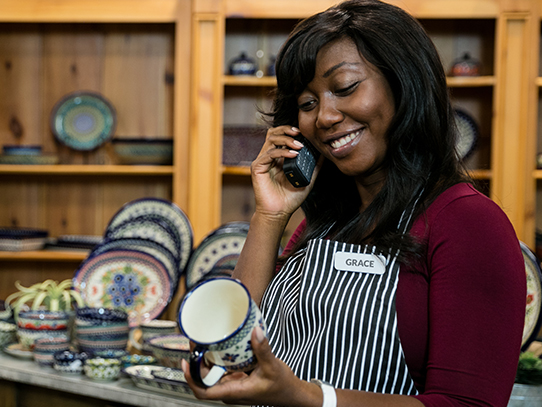Retail Revolution: 7 Retail Mobility Solutions Staff Can Use to Optimize Customer Service


The retail sector is in a period of renewal and reinvention. A major demographic swing is underway, with Millennials replacing Baby Boomers as the dominant generation retailers must cater to. In the US, Millennials have surpassed Baby Boomers as the nation’s largest living generation and in the European Union, Millennials accounted for 24% of the adult population.
Accenture predicts that by 2020, Millennials will account for nearly $1.4 trillion in spending power. They’re also the first generation of digital natives, and their affinity for technology helps shape how they shop. They are used to instant access to price comparisons, product information and peer reviews. The Millennial generation is the largest in the world and as they reach their prime working and spending years, their impact on the economy is going to be huge. So for possibly the first time in history, shoppers are now in the driver’s seat instead of retailers.
Online retailers hold a crucial advantage over their physical competitors. Digital shoppers have a wealth of knowledge readily available on the internet, allowing them to find as much information as they want in just a few clicks. To remain competitive, physical retailers must look for their own in-store solution, or risk losing ground to their online competitors. If this is your situation, the solution may be closer than you think – your staff!
Companies that have introduced in-store mobile technology believe it will empower sales associates, making them knowledgeable and informed assets. This helps them provide a level of customer service that shoppers are increasingly expecting, and turn into part of the reason consumers choose to shop in their stores.
Using mobile devices, employees can provide customers with real-time assistance, improving the customer experience by offering them in-the-moment-information such as inventory counts, sales updates, price checks, and access to store management via the ability to communicate with all in-store colleagues and other stores within the retail chain. Employees can have one-to-one conversations, share expertise, look up product information, support one another and guide new teammates, all while remaining heads-up and hands-free, to deliver better customer service and increase productivity.
This view is supported by Tulip Retail CEO, Ali Asaria:
“Retailers are discovering that retail transformation hinges on the support and enablement of truly connected store associates. We must give associates the tools to tell the brand story, answer questions and facilitate smooth transactions across channels. This change in mentality demands more than just great technology. Rather, it requires a fundamental shift in how we value and empower front-line retail staff.”
The Four P’s of Retail
Deloitte identified four themes that are key to understanding the dynamics of the current retail market and provide a framework for realizing exactly the disruption caused by the growth of online. These are:
1. Profitability: this has always been important to retailers! However, the traditional retail model has been challenged and as sales increasingly migrate online, the economics of retail are shifting.
2. Productivity: rising costs, particularly staff costs, are placing a greater focus on productivity – of people, stores and retail space.
3. Payment: the growing consumer uptake of mobile payment and digital wallets is challenging retailers to rethink the in-store experience and the way in which the checkout is managed.
4. Personalization: consumers increasingly demand personalized products and services that are relevant to them.
Seven ways that placing mobile devices in the hands of your employees can help you achieve the four P’s of retail:
1. Better Customer Service
Many retailers pride themselves on the delivery of superior in-store customer service. However, sales associate often need to leave the customer to seek an answer to a question, expecting the customer to wait around, minimizing the experience. Mobile devices ensure the associate can provide the answer immediately without leaving the customer, supporting associates on the floor interacting with customers face-to-face, helping customers find what they’re looking for and giving them access to product information more swiftly. This face-to-face interaction is a positive experience for customers.
Mobile Point of Sale (mPOS) devices have built-in scanners and credit card readers that allow sales associates to take payments, and email or text receipts from anywhere in the store, thereby cutting the time customers spend waiting in line.
2. Encourage Add-On Sales
Mobile devices can take sales associates suggesting complementary items, a step further by providing up-to-date insights on inventory, pricing (even price matching), delivery times, etc. For example, a sales associate at a home improvement store can advize customers on items that others have also purchased for similar projects, thereby eliminating a second visit to the store. And more importantly, the associate can offer advice on an online purchase, whereby the customer may have to wait for a second order delivery to complete the project. In short, empowering in-store employees with mobile devices can:
- • Facilitate inventory lookup (alternate size/color) and price searches
- • Show a customer’s sales history, allowing sales associates to make suggestions tailored to customer preferences
- • Capture impulse purchases, even after the customer leaves the store. For instance, an associate could send an email of items the customer looked at or tried on while in the store with a “buy now” option
- • Place an order for an out-of-stock item, right in the aisle, and have the item shipped to the customer’s home.
3. Enhanced Staff Management
In many countries, retail is the largest employer; however, wages and the skill-set required of the workers is typically low. Therefore, turnover tends to be high. Recruiting and training occurs constantly, but is also disruptive and costly. Inadequate staffing results in poor customer service and diminished customer satisfaction. Retailers also rely heavily on part-time help because of the fluctuation of sales volume throughout the week, time of day or season. In a survey of New York City retail workers, almost 60% of respondents reported that they were hired as part-time, temporary, holiday or full-time employees working flexible hours. In addition, a study of 11 European countries found that just over one-third of all sales and shop workers worked part-time.
Mobile devices designed with feature sets that are familiar on personal mobile devices, coupled with user-friendly applications (At Spectralink we work with AIMs Partners to deliver retail specific apps, such as enterprise mobility management, secure messaging and barcode scanning) can quickly help onboard new employees. Their productivity scales quickly when they are provided with access to promotional pricing, product information and customer information anywhere on the selling floor. All this information can be accessible from a smartphone, improving communications and staff availability. Plus, customers will see better service and responsiveness.
4. Loss Prevention
In an industry that generally operates on low margins, loss from theft, spoilage or other means has a large impact on the final profits of a retailer. The Global Retail Theft Barometer reported a total loss of $42 billion for the industry. Retailers are turning to inventory management systems and surveillance as key ways to control shrinkage. Further, technologies such as CCTV integration have moved to mobile applications so that store managers, employees and security can all have their eyes and ears on the floor. In addition, management can receive alerts when freezer is left open, potentially causing spoilage, or if an individual uses a fire escape, potentially minimizing thefts.
5. Tie the Store to the Warehouse
The central warehouse is critical to the success of many retailers including; grocery, big box and automotive parts stores. Mobile communications, workflow applications and automated alerts have a direct and positive impact on inventory distribution workflows, improving both the customer experience and the bottom line.
Warehouse managers will appreciate the reliability and durability of using specifically designed smartphones instead of their own devices (known as Bring Your Own Device or BYOD). The ability to check stock levels in the warehouse or at other locations through the barcode scanner will facilitate inventory management. Employees have access to calls without interruption.
This is key to efficient fulfilment and return processes, which again increases customer loyalty.
6. Enabling Radio Frequency Identification (RFID) Technology
While still slow in adoption, Frost & Sullivan predicts global sales of RFID readers, tags and software to the retail sector will grow from $738 million in 2014 to $5,409 billion in 2020, reflecting a compound annual growth rate (CAGR) of 38.9 percent. North America represents 44% of this market with Europe representing around of one-fifth of this market. RFID tags will be key in helping retailers manage inventory on the sales floor, reduce shrinkage and help on the supply chain side as well. RFID enables frequent inventory counting, which enables inventory accuracy.
7. Customer Intelligence
As an extension on customer loyalty programs, many retailers are significantly expanding their customer intelligence programs. The aim is to better match promotional efforts with customer’s buying needs and better engage with customers overall. Additionally, as retailers move into their omni-channel initiatives, customer intelligence programs become more important as they look to understand how customers behave and buy across a variety of channels. To implement and apply this customer intelligence, CRM system sales and development are in a growth mode.
Technology is the driving force that allows retailers to deliver seamless and engaging in-store experiences. Stores will become shopper-centric, instead of sales-centric like in the past. To gain a competitive edge over their online and physical rivals, retailers must make best use of their sales staff, ensuring they are equipped with the right knowledge in order to present customers with an efficient and pleasing experience from the moment they step in the front door. At present, this is achievable via retail mobile solutions that are customized for the omni-channel retail environment.
